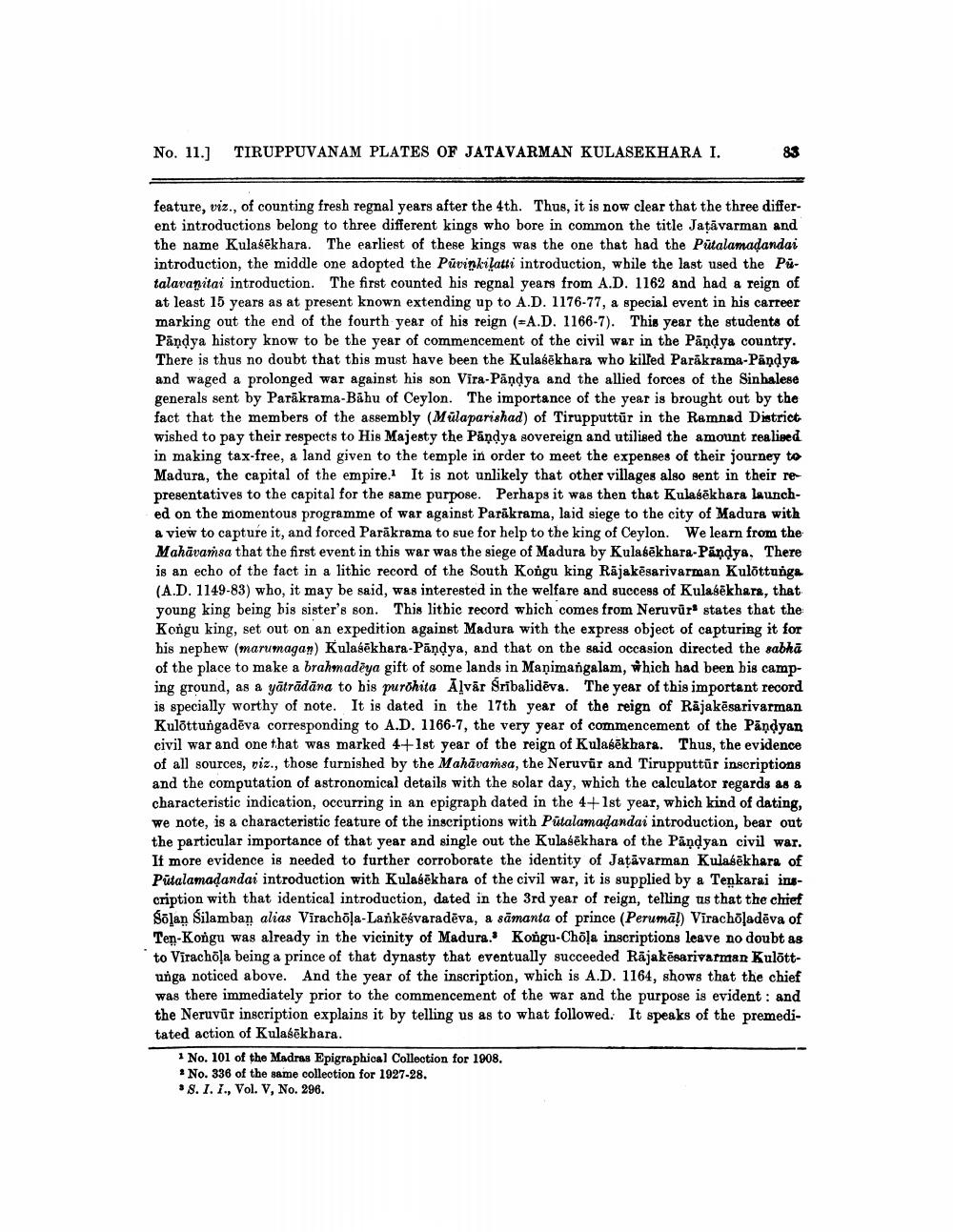________________
No. 11.)
TIRUPPUVANAM PLATES OF JATAVARMAN KULASEKHARA I.
89
feature, viz., of counting fresh regnal years after the 4th. Thus, it is now clear that the three different introductions belong to three different kings who bore in common the title Jatāvarman and the name Kulasēkhara. The earliest of these kings was the one that had the Pütalamadandai introduction, the middle one adopted the Pūvinkilatti introduction, while the last used the Petalavanitai introduction. The first counted his regnal years from A.D. 1162 and had a reign of at least 15 years as at present known extending up to A.D. 1176-77, a special event in his carreer marking out the end of the fourth year of his reign (=A.D. 1166-7). This year the students of Pandya history know to be the year of commencement of the civil war in the Pandya country. There is thus no doubt that this must have been the Kulasēkhara who killed Parākrama-Pāņdya and waged a prolonged war against his son Vira-Pandya and the allied forces of the Sinhalese generals sent by Parākrama-Bāhu of Ceylon. The importance of the year is brought out by the fact that the members of the assembly (Mülaparishad) of Tirupputtür in the Ramnad District wished to pay their respects to His Majesty the Pāņdya sovereign and utilised the amount realised in making tax-free, a land given to the temple in order to meet the expenses of their journey to Madura, the capital of the empire. It is not unlikely that other villages also sent in their representatives to the capital for the same purpose. Perhaps it was then that Kulasēkhara launched on the momentous programme of war against Parākrama, laid siege to the city of Madura with a view to capture it, and forced Parākrama to sue for help to the king of Ceylon. We learn from the Mahāvaṁsa that the first event in this war was the siege of Madura by Kulabēkhara-Pandya. There is an echo of the fact in a lithic record of the South Kongu king Rājakēsarivarman Kulõttunga (A.D. 1149-83) who, it may be said, was interested in the welfare and success of Kulasēkhara, that young king being bis sister's son. This lithic record which comes from Neruvür states that the Kongu king, set out on an expedition against Madura with the express object of capturibg it for his nephew (marumagan) Kulasēkhara-Pāņdya, and that on the said occasion directed the sabhā of the place to make a brahmadēya gift of some lands in Manimangalam, which had been bis camping ground, as a yātrādāna to his purohita Alvār Sribalidēva. The year of this important record is specially worthy of note. It is dated in the 17th year of the reign of Rajakēsarivarman Kulõttungadēva corresponding to A.D. 1166-7, the very year of commencement of the Pandyan civil war and one that was marked 4+1st year of the reign of Kulasēkhara. Thus, the evidence of all sources, viz., those furnished by the Mahāvamsa, the Neruvir and Tirupputtūr inscriptions and the computation of astronomical details with the solar day, which the calculator regards as & characteristic indication, occurring in an epigraph dated in the 4+ 1st year, which kind of dating, we note, is a characteristic feature of the inscriptions with Putalamadandai introduction, bear out the particular importance of that year and single out the Kulasēkhara of the Pandyan civil war. If more evidence is needed to further corroborate the identity of Jațāvarman Kulasēkhara of Putalamadandai introduction with Kulasēkhara of the civil war, it is supplied by a Tenkarai inscription with that identical introduction, dated in the 3rd year of reign, telling us that the chief Solan Silamban alias Virachõla-Lankēsvaradēva, a samanta of prince (Perumal) Vīrachõladēva of Ten-Kongu was already in the vicinity of Madura. Kongu-Chõļa inscriptions leave no doubt as to Virachõļa being a prince of that dynasty that eventually succeeded Rājakēsarivarman Kulottunga noticed above. And the year of the inscription, which is A.D. 1164, shows that the chief was there immediately prior to the commencement of the war and the purpose is evident : and the Neruvür inscription explains it by telling us as to what followed. It speaks of the premeditated action of Kulasēkhara.
1 No. 101 of the Madras Epigraphical Collection for 1908. * No. 336 of the same collection for 1927-28. :8. 1. 1., Vol. V, No. 296.




